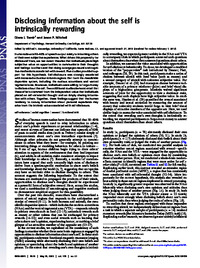Disclosing information about the self is intrinsically rewardingDiana I. Tamir, Jason P. Mitchell
Publikationsdatum:
|
 |
 Diese Seite wurde seit 7 Jahren inhaltlich nicht mehr aktualisiert.
Unter Umständen ist sie nicht mehr aktuell.
Diese Seite wurde seit 7 Jahren inhaltlich nicht mehr aktualisiert.
Unter Umständen ist sie nicht mehr aktuell.
 Zusammenfassungen
Zusammenfassungen
Humans devote 30–40%of speech output solely to informing others
of their own subjective experiences. What drives this propensity for
disclosure? Here, we test recent theories that individuals place high
subjective value on opportunities to communicate their thoughts
and feelings to others and that doing so engages neural and cognitive
mechanisms associated with reward. Five studies provided support
for this hypothesis. Self-disclosure was strongly associated
with increased activation in brain regions that form the mesolimbic
dopamine system, including the nucleus accumbens and ventral
tegmental area. Moreover, individuals were willing to forgo money
to disclose about the self. Two additional studies demonstrated that
these effects stemmed from the independent value that individuals
placed on self-referential thought and on simply sharing information
with others. Together, these findings suggest that the human
tendency to convey information about personal experience may
arise from the intrinsic value associated with self-disclosure.
Von Diana I. Tamir, Jason P. Mitchell im Text Disclosing information about the self is intrinsically rewarding (2012)  Dieser wissenschaftliche Zeitschriftenartikel erwähnt ...
Dieser wissenschaftliche Zeitschriftenartikel erwähnt ...
 Begriffe KB IB clear |  Denken Denken thinking
, thinking
,  Dopamin
, Dopamin
,  Gehirn Gehirn brain
, brain
,  Hormon
, Hormon
,  Motivation Motivation motivation
, motivation
,  Motivation, intrinsische Motivation, intrinsische
|
 Dieser wissenschaftliche Zeitschriftenartikel erwähnt vermutlich nicht ...
Dieser wissenschaftliche Zeitschriftenartikel erwähnt vermutlich nicht ... 
 Nicht erwähnte Begriffe | Motivation, extrinsische, Noradrenalin, Serotonin |
 Tagcloud
Tagcloud
 Volltext dieses Dokuments
Volltext dieses Dokuments
 |  Disclosing information about the self is intrinsically rewarding: Artikel als Volltext ( Disclosing information about the self is intrinsically rewarding: Artikel als Volltext ( : :  , 663 kByte; , 663 kByte;  : :  2021-03-21) 2021-03-21) |
 Anderswo suchen
Anderswo suchen 
 Beat und dieser wissenschaftliche Zeitschriftenartikel
Beat und dieser wissenschaftliche Zeitschriftenartikel
Beat hat Dieser wissenschaftliche Zeitschriftenartikel während seiner Zeit am Institut für Medien und Schule (IMS) ins Biblionetz aufgenommen. Beat besitzt kein physisches, aber ein digitales Exemplar. Eine digitale Version ist auf dem Internet verfügbar (s.o.). Aufgrund der wenigen Einträge im Biblionetz scheint er es nicht wirklich gelesen zu haben. Es gibt bisher auch nur wenige Objekte im Biblionetz, die dieses Werk zitieren.









 Biblionetz-History
Biblionetz-History